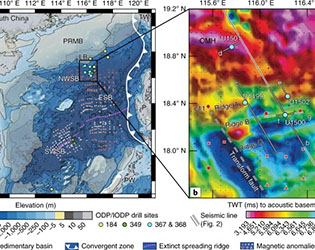

ABSTRACT: Continental breakup represents the successful process of rifting and thinning of the continental lithosphere, leading to plate rupture and initiation of oceanic crust formation. Magmatism during breakup seems to follow a path of either excessive, transient magmatism (magma-rich margins) or of igneous starvation (magma-poor margins). The latter type is characterized by extreme continental lithospheric extension and mantle exhumation prior to igneous oceanic crust formation. Discovery of magma-poor margins has raised fundamental questions about the onset of ocean-floor type magmatism, and has guided interpretation of seismic data across many rifted margins, including the highly extended northern South China Sea margin. Here we report International Ocean Discovery Program drilling data from the northern South China Sea margin, testing the magma-poor margin model outside the North Atlantic. Contrary to expectations, results show initiation of Mid-Ocean Ridge basalt type magmatism during breakup, with a narrow and rapid transition into igneous oceanic crust. Coring and seismic data suggest that fast lithospheric extension without mantle exhumation generated a margin structure between the two endmembers. Asthenospheric upwelling yielding Mid-Ocean Ridge basalt-type magmatism from normal-temperature mantle during final breakup is interpreted to reflect rapid rifting within thin pre-rift lithosphere.
Link: https://www.nature.com/articles/s41561-018-0198-1